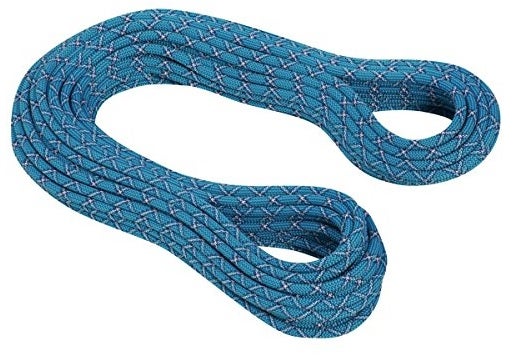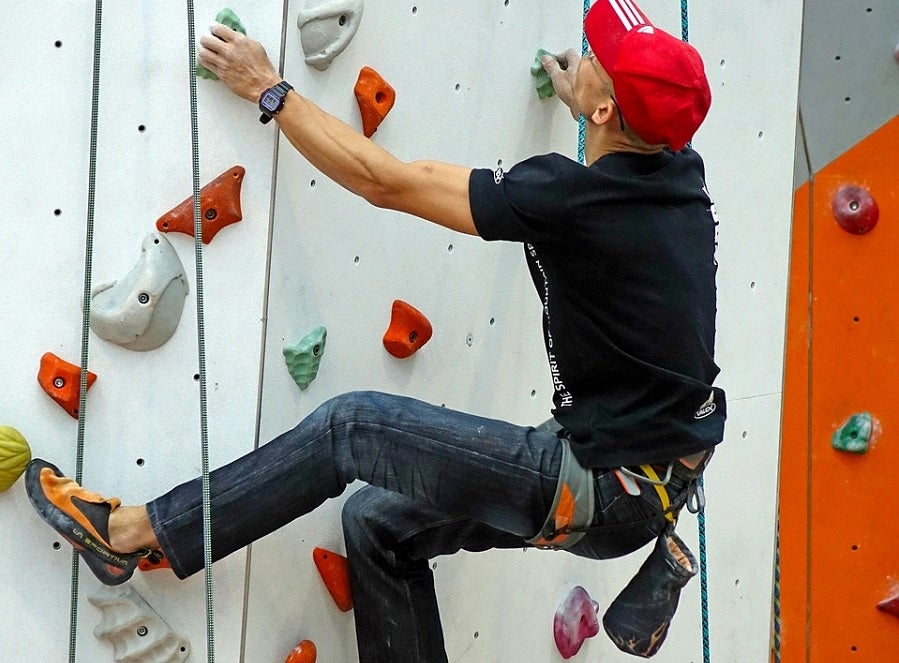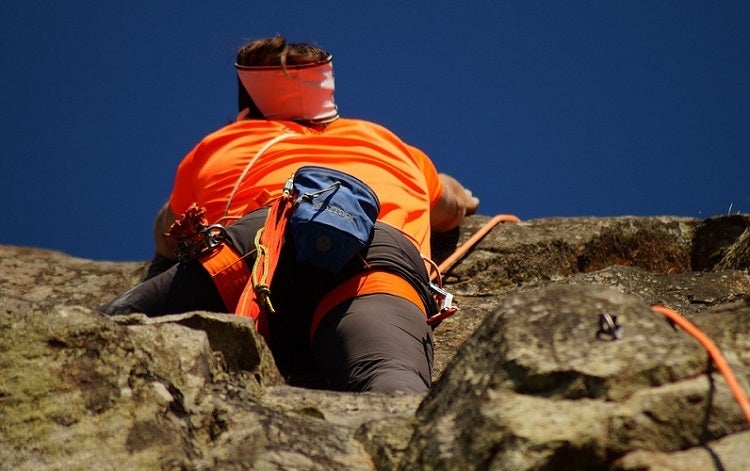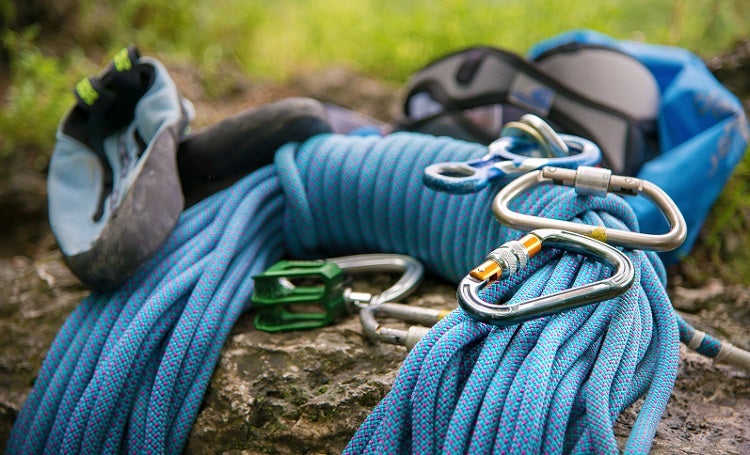
Our Editors independently research, test, and rate what we feel are the best products. We use affiliate links and may receive a small commission on purchases.
A climbing rope is one of the most essential pieces of gear for any climber.
To safely ascend a route of any length, you trust in your belayer and in the literal lifeline that is your climbing rope.
With that in mind, selecting the right kind of rope for your climbing needs results in near endless comparison when you don’t know what to look for.
Best Climbing Rope
For more of my climbing gear recommendations, have a look through these popular Outside Pursuits guide links: Harnesses, Shoes, Pants, Helmets.
Quick Answer: The 5 Best Rated Climbing Ropes For 2021
- Mammut Infinity 9.5mm Climbing Rope
- Black Diamond 9.9mm Climbing Rope
- BlueWater Ropes 9.1mm Icon Climbing Rope
- Petzl Mambo 10.1mm Climbing Rope
- Sterling Rope 10.1mm Slim Gym Climbing Rope
Whether you’re looking for your first rope or need a great companion for a specific type of climbing, we have picked the top rated climbing ropes on the market.
Climbing Rope Reviews
#1 Mammut Infinity Climbing Rope
- Dynamic Elongation: 30 %
- Impact Force: 8.4 kN
- Lengths: 40, 60 and 70 meters (43, 65 and 76 yards)
- Diameter: 9.5 mm
- Best For: Sport, alpine and trad climbing
The Mammut Infinity is a great all-around climbing rope. With a diameter of 9.5mm, it offers great balance between durability and weight, which is only 59 grams per meter.
Whether you’re doing easy sport climbing or long trad routes and multi-pitches, you can depend on good catches and easy handling with this rope.
Its special coil reduces kinks and you can belay with a range of devices, including Gri-Gris and tubes.
It performs just as well in a multi-pitch route as it does in the gym, if you’re so inclined. The standard version has a marked center, but bi-color options are available.
The rope is protected by a sheath proportion of 40 % and a Teflon coating against dirt, dust and mild abrasion.
If your looking for the best climbing rope, the Mammut Infinity is it!
#2 Black Diamond Climbing Rope
- Dynamic Elongation: 32%
- Impact Force: 8.4 kN
- Lengths: 35, 60, 70, and 80m length (38, 65, 76, and 87 yards)
- Diameter: 9.9 mm
- Best For: Sport, alpine, gym and ice climbing
Black Diamond recommends this rope for year-round rock climbing, and we can only agree.
With a diameter of 9.9mm and a weight of 64g per meter, Black Diamond delivers a burly rope optimized for durability in all situations.
Yet the rope is not too stiff and just soft enough to handle surprisingly well, whether you’re top-roping in the gym or feeding out rope to a lead-climber at your favorite crag.
The Black Diamond 9.9mm climbing rope also has a middle marker that can easily be identified and is available in 60 or 70m length (65 and 76 yards).
For a budget price, you get a durable workhorse of a rope.
If you can spend a little more to have more options with an amazing value, consider the Sterling Rope 9.8mm climbing rope: it’s an all-purpose rope for both rock and ice, very durable with firm handling, bi-color and a dry core treatment.
If you just need bi-color marking and either 60 or 70m length, the BlueWater Ropes 9.9mm Pulse climbing rope has dry treatment and is a great friend for rock and ice routes.
#3 BlueWater Ropes Icon Climbing Rope
- Dynamic Elongation: 32.7%
- Impact Force: 8.8 kN
- Lengths: 60, 70, and 80m (65, 76, and 87 yards)
- Diameter: 9.2 mm
- Best For: Alpine, trad & ice climbing
For some climbing excursions, you want to pack lightly. Every ounce matters when you’re in a multi-pitch or tackle especially long routes.
Lightweight ropes achieve a lower gram per meter ratio with a different sheath and thinner diameter. The downside: overall performance, safety and longevity can suffer.
Not so with the BlueWater 9.1mm Icon climbing rope. This rope boasts a 35% sheath mass with a diameter of just 9.1mm. Other manufacturers feature a lower sheath mass on thicker ropes.
Choose the Icon as your next skinny rope and you won’t be disappointed: a tight braid prevents the rope from wearing out quickly, dragging too much and becoming abraided.
The BlueWater rope is a great mix of lightweight performance and durability. You don’t want to wear this rope out in short gym or sport climbing routes.
It will make all the difference in alpine, trad, or even ice climbing and multi-pitch projects. A bi-color option for the Icon is available. The Bluewater is our Editors Choice for the best lightweight climbing rope.
If you want shorter length options, and an ultra-light thin rope, consider the Petzl Volta 9.2mm climbing rope. It also has a dry treatment and is suitable for rock, ice or mixed environments.
#4 Petzl Mambo Climbing Rope
- Dynamic Elongation: 37%
- Impact Force: 8.5 kN
- Lengths: 30, 40, 50, 60, 70, 200m (32, 43, 54, 65, 76, 218 yards)
- Diameter: 10.1 mm
- Best For: Sport, alpine and trad climbing
If weight is less a consideration for you and you want a climbing rope that lasts a long time with a durability you can absolutely rely on, a thickness beyond 10mm is for you.
Enter the Petzl Mambo 10.1mm climbing rope, a true snake of a rope. Especially beginners appreciate the handling of this thicker rope: the diameter facilitates friction in the belay device.
It also has a lower static and dynamic elongation value, making it easier to judge just how much a climber will fall.
The trade-off is a higher weight of 65 grams per meter and a more sturdy feel.
Yet the Petzl Mambo still handles well thanks to a specific coil which leaves the rope free of kinks and ready for climbing.
The rope has no dry treatment, but a middle mark, a finish where core and sheath are bonded at the ends to avoid fraying and a thermal treatment for core stability.
This durable rope thus offers great grip and consistent handling with excellent resistance to dust, dirt and abrasion.
You can drag it around at your gym or sport and trad climbing crags. With its superb durability, I would say the Petzl Mambo is the best rock climbing rope.
An alternative is the Sterling Rope Marathon Pro 10.1mm climbing rope, which also comes with a bi-color and dry treatment option.
#5 Sterling Rope Slim Gym Climbing Rope
- Dynamic Elongation: 35.3 %
- Impact Force: 8.6 kN
- Lengths: 25, 30 and 100m length (27, 32, 109 yards)
- Diameter: 10.1 mm
- Best For: Gym climbing
When you’re lead climbing at your gym, it’s good to have your own rope where you know exactly how much falls and wear it has already taken.
A shorter rope for the gym offers the advantages of less weight, easier handling and quicker take-up and packing when you’re done.
You can use it with a wide range of belay devices and it feeds fast with hardly any rope drag. The sheath is very durable and comprises 42% of the mass.
Even though the name suggests otherwise, the Slim Gym has a 10.1mm diameter, yet it handles like thinner rope thanks to the higher sheath mass.
There is no dry treatment, yet you can use this in dry outdoor conditions if you have short sport climbing routes where the length of this rope is sufficient.
Overall I would say the Sterling is the best gym climbing rope.
If you want a longer gym climbing rope, the BlueWater 10.2mm Eliminator at 60 or 70m is your pick. It also comes with an optional dry treatment to make it suitable for outdoor sport climbs.
Best Climbing Rope Comparison Table
| Best Climbing Rope | Dynamic Elongation | Impact Force | Lengths | Diameter | Best For | |
|---|---|---|---|---|---|---|
| Mammut Infinity Climbing Rope | 30 % | 8.4 kN | 40, 60 and 70 meters (43, 65 and 76 yards) | 9.5 mm | Sport, alpine and trad climbing | |
| Black Diamond Climbing Rope | 32% | 8.4 kN | 35, 60, 70, and 80m length (38, 65, 76, and 87 yards) | 9.9 mm | Sport, alpine, gym and ice climbing | |
| BlueWater Ropes Icon Climbing Rope | 32.7% | 8.8 kN | 60, 70, and 80m (65, 76, and 87 yards) | 9.2 mm | Alpine, trad & ice climbing | |
| Mambo Climbing Rope | 37% | 8.5 kN | 30, 40, 50, 60, 70, 200m (32, 43, 54, 65, 76, 218 yards) | 10.1 mm | Sport, alpine and trad climbing | |
| Sterling Rope Slim Gym Climbing Rope | 35.3 % | 8.6 kN | 25, 30 and 100m length (27, 32, 109 yards) | 10.1 mm | Gym climbing |
How to Choose the Best Rock Climbing Rope
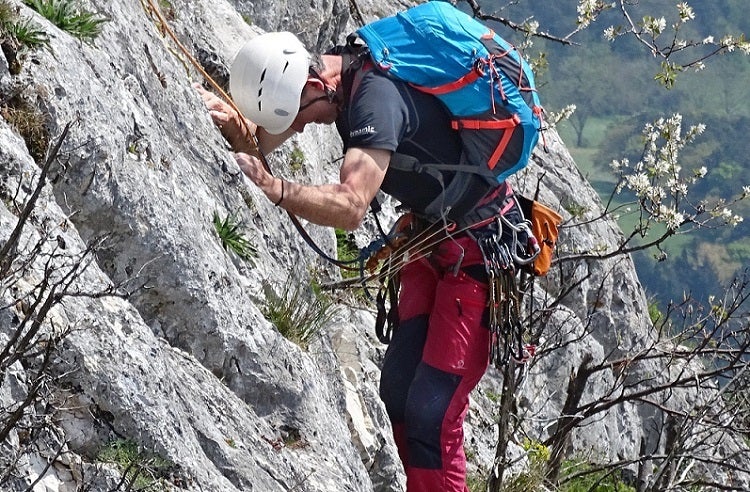
While you should never skimp on safety, it’s possible to overspend on a climbing rope if you don’t know which features are important for the type of climbing you’ll be doing most.
We’ve compiled a list of aspects you should consider when making your choice. Take into consideration where you go climbing, how long the routes are on average and if you’ll have to carry your rope around a lot.
How do you decide which climbing rope is best for you?
All the climbing ropes we have selected are single dynamic ropes. A static rope has application only for setting up a climb, rappelling or hauling gear, but you should not climb on it.
A dynamic rope is composed of a core and a sheath and an therefore stretch enough to absorb a lot of the energy of a fall. Single ropes have a diameter ranging between 8.9mm and 10.2mm and offer sufficient protection when used alone, as opposed to twin or double ropes, where a climber needs to tie into two ropes at once.
By limiting our selection to single dynamic ropes we’re able to present you with the most versatile options.
A climbing rope should be appropriate for the type of climbing you do and perform as well as handle well under the conditions you encounter.
Your choice should be guided by what length you require, where you’ll be using your climbing rope and whether you place more emphasis on durability or weight.
Diameter
The diameter of a rope tells you roughly how thick and burly it is, which influences weight, longevity, and handling. Unfortunately, there is no standard way of measuring diameter.
Some manufacturers do it under stretch (i.e. in use), others with no load on the rope. Differences in material, weaving and ratio between core and sheath will also influence how thick a rope feels and how it performs.
As a rule of thumb, a diameter between 8.9 and 9.4mm is considered a skinny rope, while 9.5 to 10mm are all-around multi-purpose ropes and above from 10.1 to 11 or even 12mm are the workhorses.
Most importantly, look at the specifications of your belay device: they will tell you which rope diameter is safest to use with your device.
From there, see if you put more emphasis on friction, thickness and durability or on lightweight and easy handling, then adjust your pick to a slightly thicker or thinner model.
Weight
As we’ve explained, weight is influenced by the diameter, but also by the material used and the weave. The weight is usually indicated in grams per square meter.
The rule of thumb is that 55 grams and lower are the ultra-light ropes, 55 to 62 are all-around climbing ropes and anything above are durable, burly options.
The weight of a rope is important not only because it will increase the total amount of gear weight, but you’ll also feel the difference as you ascend: especially in long routes, the higher you climb, the more the weight of the rope becomes an opposing force pulling at your harness.
For beginners and sport climbers, though, weight is generally less of a concern and it is the alpine and multi-pitch climbers who opt for lighter ropes.
Length
A shorter rope is of course lighter and easier to pack, but it limits the number of routes you can use it for. If you’ll lower or rappel from the anchor point at the top of a route, your rope needs to be at least double the length of the route (more if there is a lot of zig-zag).
One of the most common mistakes in climbing is to misjudge route or rope length, which can result in being stuck on the wall or even falls when the belayer feeds the end of the rope into their device or a climber rappels off the end.
Fraying ends can make it necessary to cut a rope, so it’s a safe bet to opt for a longer rope. On the other end, if you’ll only climb at the gym where no route is longer than 15m, a 30m gym rope is really all you need.
For a versatile rope that you’ll use for a long time, 60 or 70m will be your choice. 100 or 200m are mostly for big wall climbers.
One more option is to get together with your climbing partner and purchase a longer rope, then have a professional (at your gym or an outdoor shop) cut it in half with a heat knife so you end up with an off-length rope each.
Treatment
Climbing ropes often come with an option for a dry or protective treatment. This means that sheath and core have some kind of coating treatment to repel water, which increases the lifespan of your rope.
You should generally not climb with a wet rope. A rope without treatment will get significantly heavier as it’s picking up water. Dry variants are usually also better at not picking up so much dust, dirt and grime.
For alpine and ice climbing, you definitely need a rope with protection. For an all-around multi-purpose climbing rope, a treatment is good to have. You can skip it with a gym rope or a short sport climbing rope you’ll use in mild conditions.
Video: Choosing your first climbing rope.
Handling
A rope that handles well facilitates belaying, clipping and coiling your rope. Thinner ropes are easier to feed through a belay device with lower friction, but the handling also depends on the weave and material of the mantle.
Thicker ropes are stiffer, depending on the manufacturing and sheath. Beginning belayers tend to feel safer with more friction in the system, but as you climb more, you’ll appreciate a rope that doesn’t drag much and handles smoothly. Also note that now many ropes come specially coiled to avoid improper handling and kinks.
If you mishandle your rope, it can become tangled like a phone cord. These kinks are really annoying to the belayer who has to feed rope to the climber.
Durability
In your climbing career, you’ll probably buy more than one rope. As it is your lifeline, if you start having doubts about any rope, stop using it.
Thicker ropes tend to last a bit longer, since they’re more resistant to abrasion and will be more forgiving regarding dirt and improper handling. The thinner your rope, the shorter its lifespan and the more you need to take care of it.
As mentioned above, it’s a good idea to spend a little extra on a coating or surface treatment. Even if your rope will never get wet, the treatment also protects it from dirt working its way in.
A higher sheath percentage also increases longevity as the mantle will protect the core, but you’ll need to correlate that value to the diameter.
Caring For Your Rope
You can actively enhance the lifespan of your rope by taking proper care of it. Avoid dragging it through dirt and dust, avoid running it over sharp edges, and at no point should there be friction between two ropes or two parts of the same rope.
It’s worth investing in a rope bag such as the Metolius Dirt Bag, the Petzl Bucket or the Singing Rock rope backpack. At the very least, place your climbing rope on a tarp and not on the ground, and carefully clean off excessive dust and dirt with a rope brush now and then.
Markings
Nearly all ropes have a marked middle, a color or texture patch to indicate the halfway point of the rope. Rappelling and other situations become slightly easier when you’re able to quickly find the middle of your rope.
Because a simple marker can fade over time, some ropes come with a bi-color or bi-pattern option: one half features one color or pattern while the other half is distinctly different.
This means a higher price tag but is nice to have when you rapel a lot and climb multi-pitches.
Safety
The technical specifications rope manufacturers give are based on standardized fall tests using metal weights. The forces in play in actual climbing falls are different and much more dynamic.
The dynamic elongation percentage tells you the total stretch of the rope in a first test fall. It should not exceed 40% and a lower value is better (as a rule of thumb).
The specified impact force is the force transmitted by the rope to the climber in a standard test fall with a certain fall factor. Lower is better as it becomes a softer catch, but it will typically be around 8 kN.
It may not be more than 12 kN (anything beyond 15 kN can be fatal). The softness of a catch under real conditions also depends on the actions of your belayer and the total amount of rope in the system.
If you handle your rope well as we’ve described above, you’ll run a low risk of the material failing.
Do your part and avoid human error – always tie a knot into the belay end of the rope, always tie both ends into a knot when rappelling, and always do safety checks before climbing.
Outside Pursuits Overview
The technical specifications and many different climbing ropes can make it overwhelming to make a selection, especially when you’re buying your first climbing rope.
We hope our guide will help you make an informed decision to the best climbing rope for you. Remember to start with your type of climbing and where you’ll be doing it the most, then think of other conditions and route length.
For a lot of climbers and beginners, our top pick or best value rope we’ll probably do the trick. Consider ropes with treatment for ice climbing and heavy duty use. Never buy a used rope as you won’t know for sure what wear and (mis)use it has seen!
If your new to climbing be sure to read our “How to Start Rock Climbing” guide.
How We Researched
To come up with the top climbing ropes we researched a variety of sources for reviews such as REI, Dicks Sporting Goods and Backcountry along with our own personal experience.
We also consulted online magazines for product research and reviews to get as much unbiased information as we could. To help weed out fake reviews we used Fakespot.com to make sure we only looked at genuine reviews.
With so much quality gear available, we had to narrow it down based on what we felt were the best options for the price. The author, Jakob Straub has extensive experience with rock climbing and bouldering. To help narrow down the selection they used their personal experience along with recommendations from instructors and retailers.
After extensive research, we came up with our list to help you choose the right one for you.
Sources
I hope this guide was helpful for finding a good climbing rope to fit your needs. If you want to comment or recommend a rope I didn’t include, please use my contact form to get in touch.
Be safe and climb on!

